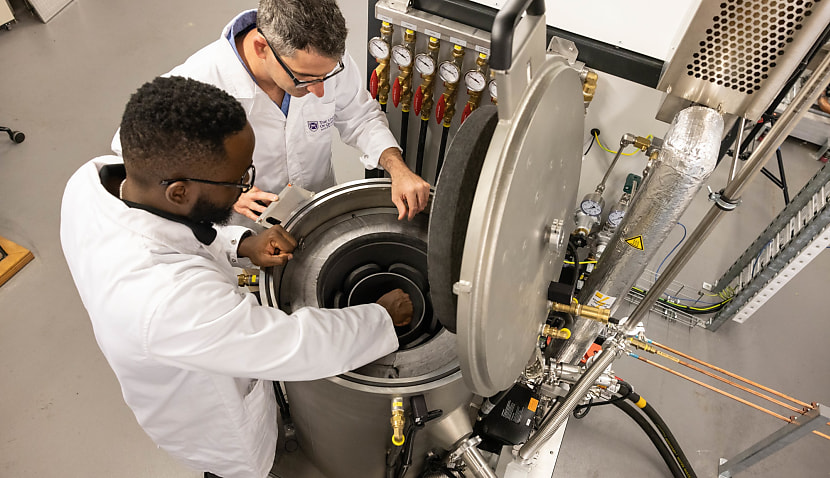
The device will be able to heat materials to almost 3,000 degrees, allowing it to replicate the extreme temperatures experienced by hypersonic vehicles as they travel faster than five times the speed of sound.
Materials made in the furnace will be used by companies such as Hypersonix Launch Systems, which has previously said it wants to one day take humans to space “like you fly with Qantas”.
While hypersonic tech is nothing new, countries are currently in an arms race to develop the next generation of missiles that are so manoeuvrable in mid-air they can’t be intercepted or detected.
Hypersonic technology is also believed to be able to one day create aircraft that can travel into space, creating an alternative to traditional vertical rocket blast-offs.
UQ Associate Professor Michael Heitzmann said hypersonic vehicles and critical components have to be made from materials that can withstand extremely high temperatures caused by aerodynamic heating.
“That’s where UQ and our new furnace at the Research Centre for Advanced Materials Processing and Manufacturing or AMPAM, comes in,” Dr Heitzmann said.
“We are working directly with industry to identify appropriate and cost-effective high-temperature ceramic matrix composites or CMCs, tailored to hypersonic flight applications.
“In areas like a rocket nozzle or a hypersonic vehicle, the temperatures we’re talking about approach those only seen on the surface of the sun.
“We are trying to get the utmost temperature resistance out of our material and find the most thermal-resistant materials possible.
“We are pioneering CMC manufacturing in Australia – it is a rare class of material because it’s extremely lightweight and has exceptional heat resistance.”
Hypersonix’s manufacturing lead, Sam Grieve, said the UQ team would produce an engine part for DART AE, a three-metre-long, single-use vehicle powered by a hydrogen-fuelled SPARTAN scramjet engine.
“The insert is in a part of the engine that could be subjected to temperatures more than 1,300 degrees Celsius due to hypersonic flows and shock waves,” Grieve said.
“Normal metal alloys would fail at that temperature, so we need high-performance, lightweight materials to ensure the engine will survive in flight.”
Grieve said UQ’s AMPAM group would have a capability to produce high-quality CMCs with temperature resistance not previously possible in Australia.
“This is a very important sovereign capability and an important puzzle piece in establishing an Australian space and hypersonics industry,” he said.
“The ultimate goal for Hypersonix is a multi-mission autonomous vehicle capable of delivering satellites to orbit while producing no CO2 in its exhaust.
“Our engineering team is excited to be working with UQ to deliver outcomes that could see Hypersonix competing internationally and to see Australia at the forefront of international space technologies.”
The CMC components are manufactured within UQ’s AMPAM Research Centre using fabrication techniques such as winding with a filament winding machine. During this process, carbon fibre threads are wound onto filament reels and fed onto a rotating mandrel.
“Having this capability allows us to pair our materials research with industry-relevant manufacturing process and it also gives us the ability to manufacture prototype components,” Dr Heitzmann said.
“The filament winder will also give our extracurricular student teams from UQ Space and UQ Racing the ability to manufacture components at an unprecedented performance level and using industry ‘best-practice’.
“The companies we work with are at the forefront of Australia’s efforts to achieve access to space or prolonged hypersonic flight, which is a milestone achievement.
“The investment in our capabilities enhances the potential for our partners to deliver real impact and puts our students in touch with space-age manufacturing technologies.”
The furnace will also be used to produce 3D-printed materials for biomedical applications, battery materials, and a new generation of renewable carbon fibres.
“AMPAM is very keen to understand the problems of industry, and we’re eager to work in partnership to solve these super challenging problems.”
It comes after Space Connect reported last month how Hypersonix Launch Systems agreed a deal to provide 20 of its hypersonic “spaceplanes” to the NASDAQ-listed defence firm Kratos.
The company hopes the deal, which will go through once the system has been successfully demonstrated, will allow it to “significantly” expand its presence in the US.
The announcement comes months after Hypersonix was chosen to supply the US Department of Defense with one of its vehicles for testing in a breakthrough moment for the local hypersonic industry.

Adam Thorn
Adam is a journalist who has worked for more than 40 prestigious media brands in the UK and Australia. Since 2005, his varied career has included stints as a reporter, copy editor, feature writer and editor for publications as diverse as Fleet Street newspaper The Sunday Times, fashion bible Jones, media and marketing website Mumbrella as well as lifestyle magazines such as GQ, Woman’s Weekly, Men’s Health and Loaded. He joined Momentum Media in early 2020 and currently writes for Australian Aviation and World of Aviation.
Receive the latest developments and updates on Australia’s space industry direct to your inbox. Subscribe today to Space Connect here.









